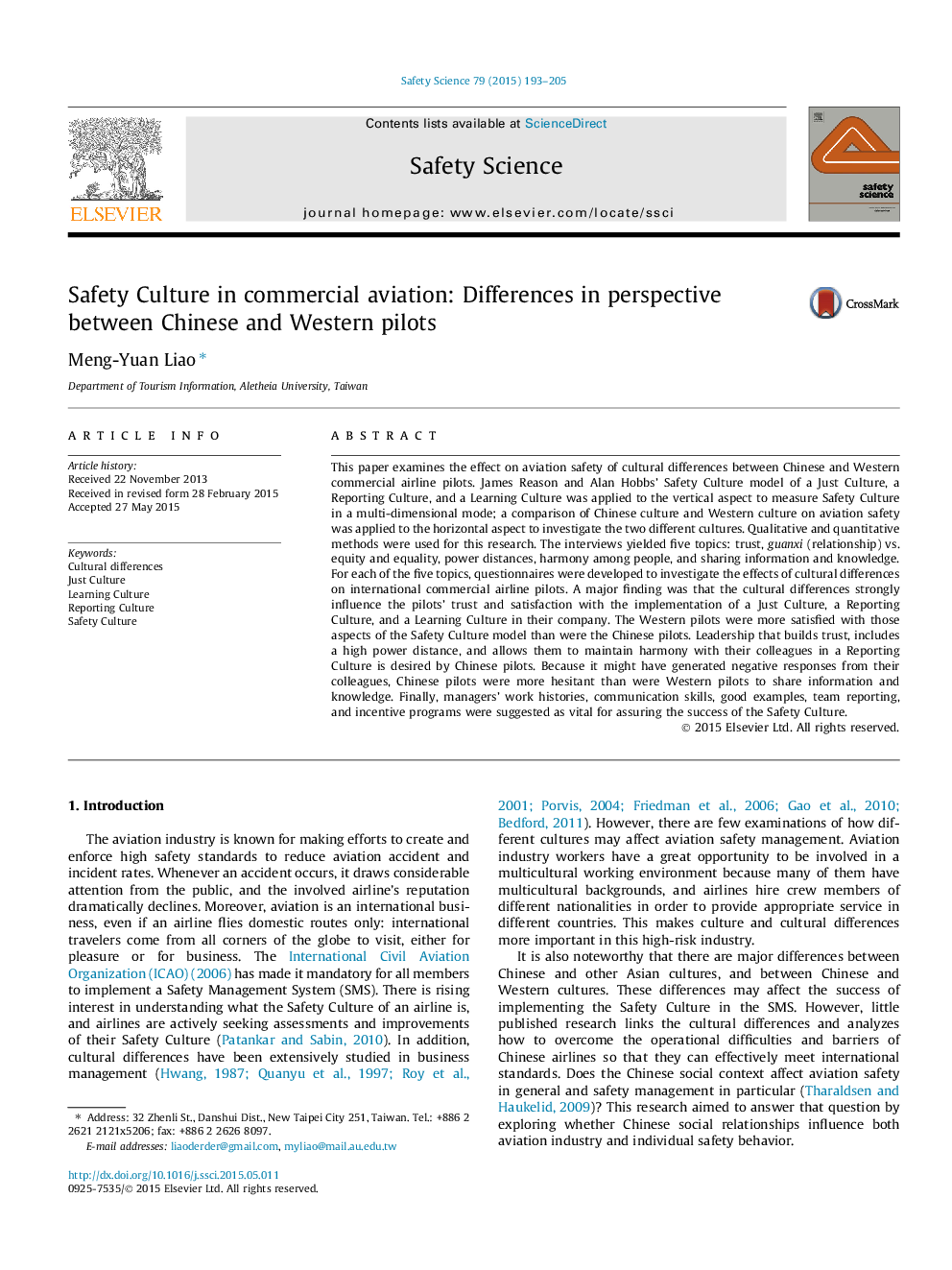| کد مقاله | کد نشریه | سال انتشار | مقاله انگلیسی | نسخه تمام متن |
|---|---|---|---|---|
| 6975679 | 1453392 | 2015 | 13 صفحه PDF | دانلود رایگان |
عنوان انگلیسی مقاله ISI
Safety Culture in commercial aviation: Differences in perspective between Chinese and Western pilots
ترجمه فارسی عنوان
فرهنگ ایمنی در هواپیمایی تجاری: تفاوت بین چشم انداز بین خلبانان چینی و غربی
دانلود مقاله + سفارش ترجمه
دانلود مقاله ISI انگلیسی
رایگان برای ایرانیان
کلمات کلیدی
تفاوت های فرهنگی، فقط فرهنگ فرهنگ آموزشی فرهنگ گزارشگری، فرهنگ ایمنی،
ترجمه چکیده
این مقاله اثر ایمنی حمل و نقل هوایی تفاوت های فرهنگی بین خلبانان خطوط هوایی تجاری چین و غرب را مورد بررسی قرار می دهد. جیمز ایزن و الن هابز، مدل فرهنگ ایمنی یک فرهنگ درست، یک فرهنگ گزارشگری، و یک فرهنگ آموزشی برای جنبه عمودی برای اندازه گیری فرهنگ ایمنی در حالت چند بعدی اعمال شد؛ مقایسه فرهنگ فرهنگی و فرهنگ غربی در مورد ایمنی حمل و نقل هوایی به ابعاد افقی برای بررسی دو فرهنگ متفاوت انجام شد. روشهای کیفی و کمی برای این پژوهش مورد استفاده قرار گرفت. مصاحبه ها پنج موضوع را به میان آوردند: اعتماد، گوانشی (روابط) در مقابل صلاحیت و برابری، اختلافات قدرت، هماهنگی بین مردم و به اشتراک گذاری اطلاعات و دانش. برای هر یک از پنج موضوع، پرسشنامه ها برای بررسی تأثیرات تفاوت های فرهنگی در خلبانان هواپیمایی تجاری بین المللی طراحی شده است. یافته های عمده این بود که تفاوت های فرهنگی به شدت بر اعتماد و رضایت خلبانان در اجرای یک فرهنگ درست، فرهنگ گزارشگری و فرهنگ آموزشی در شرکت تاثیر می گذارد. خلبانان غربی با آن جنبه های مدل فرهنگ ایمنی بیشتر از خلبانان چینی بودند. رهبری که اعتماد را ایجاد می کند، شامل فاصله ای قدرتمند است و اجازه می دهد تا آنها را در حفظ هماهنگی با همکاران خود در یک گزارشگر فرهنگی توسط خلبانان چینی مورد ارزیابی قرار دهد. از آنجایی که ممکن است پاسخ های منفی از همکاران خود ایجاد کرده باشد، خلبانان چینی بیشتر از خلبانان غربی برای به اشتراک گذاشتن اطلاعات و دانش بیشتر تردید دارند. در نهایت، تاریخچه کار مدیران، مهارت های ارتباطی، نمونه های خوب، گزارشدهی تیم و برنامه های انگیزشی برای تأمین موفقیت موفقیت فرهنگ ایمنی پیشنهاد شد.
موضوعات مرتبط
مهندسی و علوم پایه
مهندسی شیمی
بهداشت و امنیت شیمی
چکیده انگلیسی
This paper examines the effect on aviation safety of cultural differences between Chinese and Western commercial airline pilots. James Reason and Alan Hobbs' Safety Culture model of a Just Culture, a Reporting Culture, and a Learning Culture was applied to the vertical aspect to measure Safety Culture in a multi-dimensional mode; a comparison of Chinese culture and Western culture on aviation safety was applied to the horizontal aspect to investigate the two different cultures. Qualitative and quantitative methods were used for this research. The interviews yielded five topics: trust, guanxi (relationship) vs. equity and equality, power distances, harmony among people, and sharing information and knowledge. For each of the five topics, questionnaires were developed to investigate the effects of cultural differences on international commercial airline pilots. A major finding was that the cultural differences strongly influence the pilots' trust and satisfaction with the implementation of a Just Culture, a Reporting Culture, and a Learning Culture in their company. The Western pilots were more satisfied with those aspects of the Safety Culture model than were the Chinese pilots. Leadership that builds trust, includes a high power distance, and allows them to maintain harmony with their colleagues in a Reporting Culture is desired by Chinese pilots. Because it might have generated negative responses from their colleagues, Chinese pilots were more hesitant than were Western pilots to share information and knowledge. Finally, managers' work histories, communication skills, good examples, team reporting, and incentive programs were suggested as vital for assuring the success of the Safety Culture.
ناشر
Database: Elsevier - ScienceDirect (ساینس دایرکت)
Journal: Safety Science - Volume 79, November 2015, Pages 193-205
Journal: Safety Science - Volume 79, November 2015, Pages 193-205
نویسندگان
Meng-Yuan Liao,
